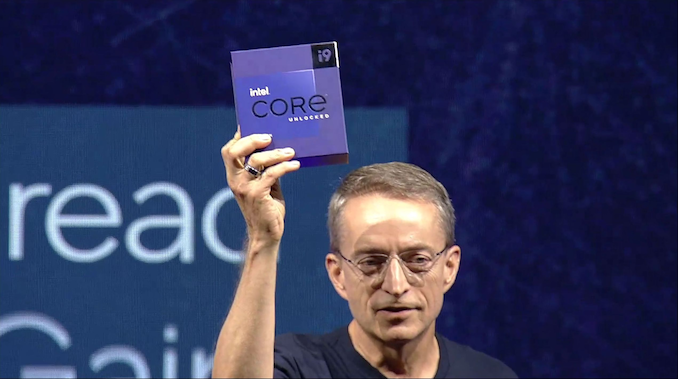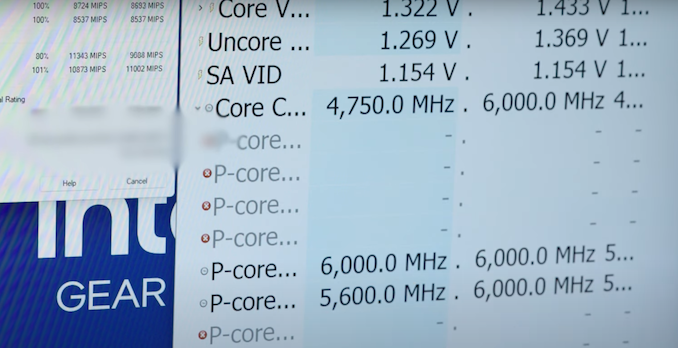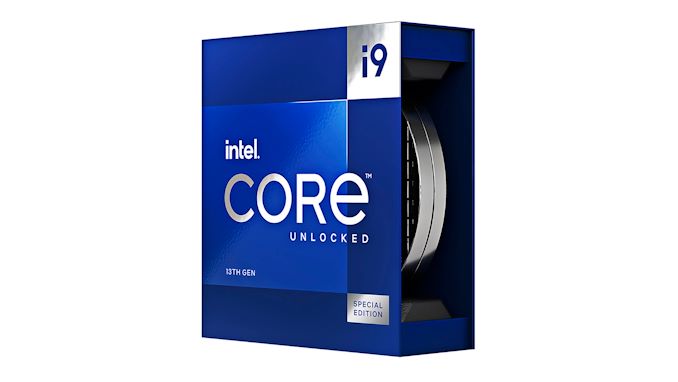Intel Unveils Core i9-13900KS: Raptor Lake Spreads Its Wings to 6.0 GHz
by Gavin Bonshor on January 12, 2023 9:00 AM EST
Initially teased by Intel CEO Pat Gelsinger during their Innovation 2022 opening keynote, Intel has unveiled its highly anticipated 6 GHz out-of-the-box processor, the Core i9-13900KS. The Core i9-13900KS is a special, highly clocked bin of the regular i9-13900K, offering the same 24-core (8P+16E) hybrid architecture, but with an impressive P-core maximum turbo clockspeed of up to 6 GHz.
Based on Intel's existing Raptor Lake-S desktop silicon, Intel claims that the Core i9-13900KS is the first desktop processor to reach 6 GHz out of the box without overclocking. With normal chips hitting up to 5.8GHz, the i9-13900KS is an even more extreme bin of that silicon, with Intel identifying chips that can run even harder to make it to 6 GHz. The trade-off for this extra burst of performance is that the power consumption of the chip is even higher than Intel's usual high-end desktop parts, with an official TDP of 150 Watts, and an "extreme" power profile that goes as high as 320 Watts under load.
Meanwhile, unlike most Intel CPU launches, the company is wasting no time on bringing their new special edition chip to market: the $699 CPU is available immediately.
Intel Core i9-13900KS: 6 GHz P-Core Turbo For $699
The Core i9-13900KS has been a long-awaited entrant to Intel's Raptor Lake-S for desktop family, with previous hints from Intel during their Innovation 2022 keynote that a 6 GHz out-of-the-box processor was on the horizon for this generation. As Intel likes to proclaim, the company considers the Core i9-13900KS to be a significant milestone for desktop PCs, thanks to its 6 GHz out-of-the-box P-Core turbo frequency. This makes it one of the fastest desktop x86 processors ever released, at least from the perspective of users who won't need to overclock anything to attain these ridiculous core frequencies.
This screenshot is taken directly from Intel's Core i9-13900KS promotional video
From Intel's sneak peek video on YouTube which was published on January 10th, the Core i9-13900KS looks to have reached 6 GHz on two of the eight performance (P) cores, with a clock speed of up to 5.6 GHz on the remaining six cores, which is very impressive, even for the already-capable Raptor Lake silicon. Intel hit 5 GHz on a shipping consumer CPU just a bit under three and a half years ago with the Core i9-9900KS, so this latest push to 6 GHz has come relatively quickly compared to the overall relaxed pace the x86 CPU frequencies have been moving at over the last decade or so.
Like its predecessor KS parts, the i9-13900KS is a special bin of Intel's existing silicon. Judging from end-user reports of overclocking the normal Core i9-13900K, we're left with the impression that very few of those chips could hit 6 GHz with ambient air cooling. So the i9-13900KS appears to be a very thin bin, though unlike the i9-12900KS launch, we haven't heard any official statistics from Intel this time around.
Of course, with even higher clockspeeds pushing the chip even farther away from the sweet spot on the voltage-frequency curve, the power consumption of this special edition chip has also gone up. The base TDP (as defined by Intel) is now 150 Watts, up from 125 W for the regular i9-13900K.
More interesting are the PL1 and PL2 power limits. For their latest chief chip, Intel has actually created two official power profiles, which is something they've never done before. The "base" profile sees both PL1 and PL2 set at 253 Watts; this is the same PL2 (turbo limit) as the i9-13900K, but PL1, the long-term expected steady state power consumption of a processor, his been boosted significantly from 125 W to the same 253 W value. PL1 is normally synonymous with a chip's official TDP, so I'm not sure the 150 W figure has much relevance here.
And for system builders that truly want to throw energy efficiency into the wind in favor of peak performance, the new "Extreme" power delivery profile further raises both PL1 and PL2 to 320 W, which correlates to an ICCMax current of 400 Amperes. While it (hopefully) shouldn't be necessary for the i9-13900KS to hit 6 GHz on its handful of favored cores, the extra power should come in handy for helping the remaining CPU cores also hold high clockspeeds, especially under heavy multi-threaded workloads.
Intel at this point hasn't specified how the multiple profiles will work (despite chips going on sale today), but between motherboard settings and Intel's XTU utility, one or both will undoubtedly have access. Otherwise, since the new extreme power profile is an official profile, Intel has confirmed that their standard warranty covers this higher powered mode.
Intel's current Intel 13th Gen Core i9 Series stack stands as follows (as of 01/12/23):
| Intel 13th Gen Core i9 Series: Raptor Lake-S (As of 01/12) | ||||||||||
| AnandTech | Cores P+E/T |
P-Core Base |
P-Core Turbo |
E-Core Base |
E-Core Turbo |
L3 Cache (MB) |
IGP | Base W |
Turbo W |
Price ($) |
| i9-13900KS | 8+16/32 | 3200 | 6000 | 2400 | 4300 | 36 | 770 | 150 | 253/320 | $699 |
| i9-13900K | 8+16/32 | 3000 | 5800 | 2200 | 4300 | 36 | 770 | 125 | 253 | $589 |
| i9-13900KF | 8+16/32 | 3300 | 5800 | 2200 | 4300 | 36 | - | 125 | 253 | $564 |
| i9-13900 | 8+16/32 | 2000 | 5600 | 1500 | 4200 | 36 | 770 | 65 | 219 | $549 |
| i9-13900F | 8+16/32 | 2000 | 5600 | 1500 | 4200 | 36 | - | 65 | 219 | $524 |
| i9-13900T | 8+16/32 | 1100 | 5300 | 800 | 3900 | 36 | 770 | 35 | 106 | $549 |
Comparing the Core i9-13900KS special edition processor directly to the regular Core i9-13900K, almost every clockspeed value has been cranked up to some degree. Thanks to the higher TDP, the official base clockspeeds for both the P and E cores are 200MHz higher, bringing them to 3.2 GHz and 2.4 GHz respectively. Meanwhile the highest turbo boost clockspeed on the P cores is now 6 GHz.
Like the basic i9-13900K, it's important to note that this is not an all-core turbo value – that is, not all 8 P cores will hit 6 GHz. As with the 5.8 GHz peak clockspeed on that chip, this is achieved by layering Intel's Thermal Velocity Boost (TVB) technology on top of their Turbo Boost Max 3.0 technology. Which to simplify things, means that the clockspeed is only guaranteed to be available on the chip's favored core pair, and even then only when the processor is running cool enough that there's enough thermal headroom to punch up the final 200MHz to 6 GHz.
Otherwise, the normal all-core turbo limit for the remaining P cores is 5.4 GHz, which means they can top out at 5.6 GHz when TVB is available. Meanwhile the E cores get no such love, and their turbo limit remains at 4.3 GHz, the same as on the regular i9-13900K.
Rounding out the package, the Core i9-13900KS offers the same 36 MB of L3 cache as Intel's other top-tier Raptor Lake desktop chips. And this is a graphics-enabled SKU, so Intel's UHD 770 integrated graphics are available.
Intel hasn't clarified how many Core i9-13900KS parts will be available during the lifecycle of Raptor Lake-S. As we've seen with previous iterations of its KS edition SKUs, there are typically a limited number of processors produced. Though as the high price tag also means that Intel moves relatively few chips overall, this is primarily an opportunity for Intel to show off with one faster chip.
Intel Client Computing Group (CCG) Manager Marcus Kennedy stated that "The Core i9-13900KS continues our 13th Gen Intel Core desktop processor family excellence, showcasing the new performance heights made possible by our performance hybrid architecture". He also said, "Extreme gamers and enthusiasts can now push their everyday performance further than ever before with the first desktop processor in the PC industry to provide 6.0 GHz speeds at stock".
The Intel Core i9-13900KS is available to buy now at PC retailers, with an MSRP of $699. Officially, this is $40 cheaper than the previous Core i9-12900KS, which launched last year at $739. Otherwise, based on current street prices, initial listings have the chip at closer to $729, which is $130 more than the i9-13900K ($599).












100 Comments
View All Comments
philehidiot - Monday, January 16, 2023 - link
I have a H105 AIO which I bought in 2014. It's still going and has been my main cooler since. I now use it on a 3900X and have zero thermal or performance issues. It is closely monitored. There's an air filter that is cleaned when it gets manky, but no other maintenance. I've been doing this a long time and I actually can't remember when I last had a fan failure personally. I've seen it happen and I've replaced them on others but never personally. I've run a PSU with a full time fan in for something like 9 years before exchanging it. The guy I gave it to is still running it.When this AIO begins to show signs of failure (I've got alarms set up now, as it's making me twitchy), I'm undecided whether I'll go for another AIO or a large air cooler.
AIOs definitely have their place. As do air coolers. Calm down.
jakky567 - Tuesday, January 17, 2023 - link
Yep! I refuse to go to water cooling.meacupla - Friday, January 13, 2023 - link
CLCs are valid options. There are just build quality variations with them. The good quality ones, mounted properly, will last more than 2yrs. More like 7yrs with minimal maintenance.With the heat output of CPUs these days, CLCs and custom water cooling will be the only option with top end CPUs.
A 360mm or 420mm radiator has more heat capacity than a dual tower 140mm air cooler, so IDK what your complaint there is.
Do CLCs require more care with how it's oriented in the case when compared to air coolers? yes.
Are there vast build quality discrepancies between different brands and models? yes.
Are CLCs better at cooling than air coolers? Actually, yes. Just be sure to get a 280mm, 360mm, 420mm, or 480mm sized one. There is not a single air cooler that can keep up with the sheer volume and surface area of larger CLCs.
Silver5urfer - Friday, January 13, 2023 - link
Unfortunately DH15 cannot keep up with the heat density of the Intel 11th gen + parts essentially anything over 300W is harder and impossible to keep it tamed. Only 360mil+ CLC can do the job. Note heat density, the high output of heat coming from Intel 11th gen and up is very very high and it will saturate even a CLC pretty fast. i9 12th gen and i7, i9 for 13th gen are impossible to cool on an Air cooler.Noctua should release a successor. The problem with CLC is microfins, over the time it will become clogged and water will become messy, although it depends on how much usage you are doing to see how fast it can go bad. So that is definitely a thing. If anyone plans to keep a machine for decades, then Water cooling is no go. No matter open or close the microfins will be clogged. Open loop you can clean but it needs a lot of maintenance. CLC no such option, any leak or such = whole system will be down.
I want zero risk esp when I'm dealing with WD Gold drives in my machine so I went with a DH15 Chromax for my i9 10900K no fuss. The annoyance of mounting and GPU cannot be removed easily nor Cooler is a mega downside also unfortunately I use ASUS's DIMM.2 else no issues with DRAM clearance for 2nd fan, so I had to use NFA12x25mm.
So all this complexity many do not want and go with CLC only.
Samus - Friday, January 13, 2023 - link
CLC is complex. A tower cooler with a fan is as simple as it gets. And cheaper tower coolers (or even $100 Noctua's that are similarly priced to a low-end CLC) will beat them 10 out of 10 times in almost every way, while lasting "forever."I've never seen a CLC last 7 years. The pumps are generally rated at 25,000 hours. That's 2.5 years and anything beyond that you are on borrowed time. A general google search will reveal the average lifespan is 1-3 years.
Oxford Guy - Friday, January 13, 2023 - link
My H50 (I think it was called), exploded — destroying a motherboard and video card and covering the inside of a case with whitish splatter.philehidiot - Monday, January 16, 2023 - link
I'm definitely on borrowed time then... 9 years...Samus - Monday, January 16, 2023 - link
9 years is anecdotal experience. Thousands of reviews between Newegg, Amazon, and just typing into google "how long to CLC's last" will give you an average window of 3 years.If you actually got 9 years of continuous use out of a CLC, it must have been one of the early Asetek models with a full ceramic pump. Those were rated for 100,000 hours. The only CLC I know of ever made with such a rating. You'd know because the pump\waterblock is cylindrical and quite tall.
Pneumothorax - Saturday, January 14, 2023 - link
You can tame a Alder/Raptor lake for a NHD15, but you do leave some performance on the table. I usually have to power limit them to <200 watts to have some noise control. There is still some throttling however.corinthos - Sunday, January 22, 2023 - link
Would you leave less/no performance on the table with 7950x and NHD15 instead of 13900K?